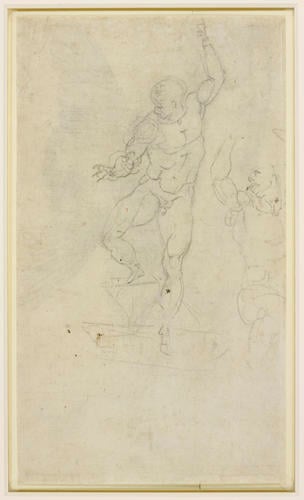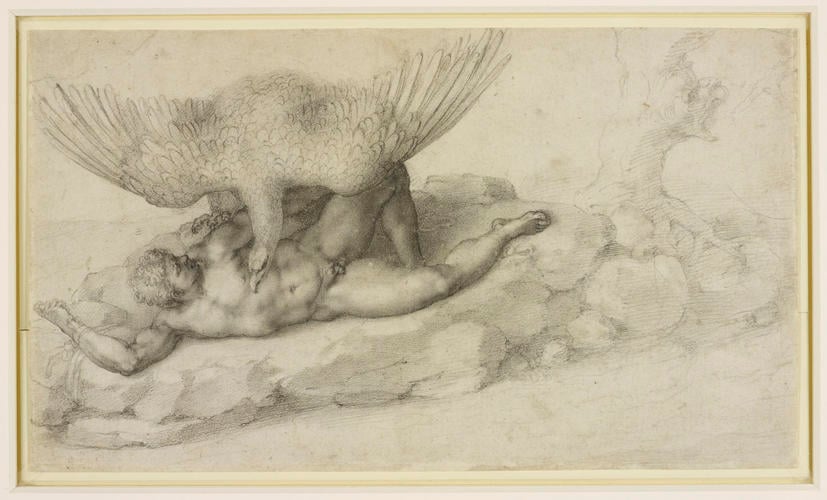-
1 of 253523 objects
The Punishment of Tityus 1532
Black chalk; charcoal on the verso | 19.0 x 33.0 cm (sheet of paper) | RCIN 912771

Michelangelo Buonarroti (Caprese 1475-Rome 1564)
The Punishment of Tityus 1532


-
A highly finished black chalk drawing of the punishment of Tityus, tied to a rock as a vulture tears at his liver. On the verso, two sketches of the Risen Christ.
In a myth recounted in Ovid’s Metamorphoses, the giant Tityus was punished for attempting to rape Lato, mother of Apollo and Diana, by being chained to a rock in Hades. Every day a vulture would rip out his liver, the seat of lust; every night the liver would grow back, for the torment to be repeated the next day, for all eternity. Dante’s Divine Comedy (Inferno XXXI, v. 124) also mentions Tityus as one of the giants punished for their violence.
The drawing is one of four stated by Michelangelo's biographer Giorgio Vasari (Lives of the Artists, 1550 and 1568) to have been presented as gifts to the young Roman nobleman Tommaso de' Cavalieri. Shortly before the end of 1532, the artist wrote for the first time to Cavalieri, who was then ill. His letter (which no longer exists) was accompanied by two drawings. In his reply - his first letter to the artist, dated 1 January 1533 – Cavalieri thanks Michelangelo for the two drawings, and says that he spends two hours each day studying them (‘In questo mezo mi pigliaro al manco doi hore del giorno in contemplare vostri disegni che Pierantonio [Cecchini, a sculptor, who delivered the letter] mi a portati, quali, quanti piu li miro, tanto piu piaccioni’). Those two drawing were almost certainly the present sheet and a Ganymede, now lost but known in numerous copies (including RCIN 913036) and engravings.
Both formally and thematically, Tityus and Ganymede were a pair, each depicting a single nude dominated by a huge bird. The Ganymede depicted the beautiful young shepherd abducted and carried heavenwards by Jupiter in the form of an eagle. The drawings thus represent, in Neoplatonic philosophy, the twin poles of love: in Tityus, carnal lust prompted by our base nature that condemns us to torture in the deepest pit, and in Ganymede, spiritual love inspired by beauty that sees our souls elevated – not just a fleeting rapture, but the permanent transcendence of the soul. These two states of being can be extended to human life in general – the benighted state of the merely material, contrasted with the enlightened state of the presence of the divine. The Tityus has often been seen as a ‘confession’ of Michelangelo’s love for the young Cavalieri, but its moral lesson is more general, that physical passion should be controlled.
Though the scene is one of damnation and degradation, Michelangelo drew the vulture with a form as noble as that of an eagle, and the degenerate giant with an expression of fortitude rather than agony, hardly struggling against his inadequate bondage – at first glance he might instead be the hero Prometheus. The vulture’s beak has not yet pierced Tityus’ skin, and thus his heroically proportioned torso is undefiled. A crab seems to lurk among the rocks at lower centre; to the right, a tree houses the screaming mask of another soul trapped in the underworld (which may allude to the suicides imprisoned in trees in Inferno XIII - Michelangelo was known to be well versed in the works of Dante). What seems to be a small figure fleeing from that mask is in fact a branch of the tree – the sheet has been cut down by an earlier collector, separating the branch from the trunk.
The drawing was famous from an early date: it was borrowed from Cavalieri to be copied. In a letter to Michelangelo on 6 September 1533, Cavalieri reports that Cardinal Ippolito de’ Medici wished to commission rock-crystal intaglios of Michelangelo’s Tityus and Ganymede from the gem engraver Giovanni Bernardi; he apologised that he had not been able to save the Tityus: 'Il Cardinal de’ Medici à voluto veder tutti li vostri disegni. E sonnogli tanto piaciuti che voleva far fare quel Titio e’l Ganimede in cristallo; e non ò saputo far sì bel verso che non habbia fatto far quel Titio, e ora il fa il maestro Giovanni. Assai ò fatto a salvare il Ganimede.' ('Cardinal de’ Medici wished to see all your drawings, and they pleased him so much that he wanted to have that Tityus and the Ganymede made in crystal; I couldn’t see how to prevent him from having the Tityus made, and master Giovanni is doing it now, I worked very hard to save the Ganymede.') The resulting intaglio by Bernardi is now in the British Museum (1867,0507.739).
The outlines of the sheet appear to have been pressed around with a stylus to effect a tracing, and there exist engravings (eg. by Nicolas Beatrizet, RCIN 830379-80) and facsimile-type drawings after the sheet, including RCIN 990471 (attributed to Bronzino); RCIN 990472 (anonymous); Uffizi 248-F (earlier attributed to Bronzino, then Alessandro Allori, and more recently to Francesco Morandini, Il Poppi); Allen Memorial Art Museum, Oberlin, inv. 2014.9 (from the collection of Nicolas Lanier); and a drawing formerly in the Savoia-Aosta collection (Christie’s, London, 4 July 2006, lot 5, attributed to Giulio Clovio). One such copy was the model for Rubens in his paintings of Prometheus (Philadelphia Museum of Art) and Death of Hippolytus (Fitwilliam, Cambridge), among many other derivations.
On the verso of the drawing, are two sketches, one fragmentary, of the Risen Christ, among a long series of studies of the Resurrection drawn by Michelangelo in the early 1530s (see RCIN 912767). The outlines of the main figure correspond with those of Tityus on the recto, with an adjustment to the legs. It is usually assumed that Michelangelo drew the Tityus first, and then traced through the outlines onto the verso to create the Christ. But the Christ is in a natural pose for that subject, whereas Tityus is highly contrived; it is perhaps more plausible that the Christ was sketched first, and that Michelangelo traced through those outlines, turning the sheet through ninety degrees to create an entirely novel pose.Provenance
Tommaso de' Cavalieri; Emilio de' Cavalieri, from 1587; Cardinal Odoardo Farnese, by 1602; listed in George III's 'Inventory A', c. 1800-20, p. 45, ‘Mich: Angelo Buonaroti' / Tom. II (c. 1802): '6. 'Prometheus….D°'
-
Creator(s)
-
Medium and techniques
Black chalk; charcoal on the verso
Measurements
19.0 x 33.0 cm (sheet of paper)
Category
Object type(s)
Other number(s)
Alternative title(s)
Verso: The Risen Christ